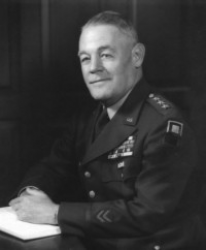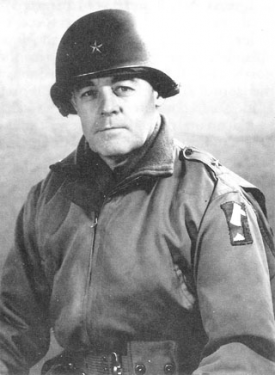
 |
|
|
||
|
Thomas Wade Herren |
||||
|
Engagements: • World War I (1914 - 1918)• World War II (1941 - 1945)• Korean War (1950 - 1953) |
||||
| Biography: | ||||
|
Thomas Wade Herren Thomas Wade Herren was born in Dadeville, AL, on 9 August 1895. He graduated from Tallapoosa Country High School in 1914 and from the University of Alabama in 1917. After a few months as a high school teacher in Gadsden, AL, he enrolled as an officer candidate in the first officers training camp at Fort McPherson, GA, in May 1917. He was commissioned a provisional Second Lieutenant in the Regular Army on 15 August 1917 and assigned to the 78th Field Artillery at Fort Bliss, TX. After a brief course at the Field Artillery School, he accompanied his regiment to France as a battery executive officer, and then commander, until it was demobilized. Between the World Wars Following World War I, Herren was troop commander (Troop A) in the 3rd Cavalry Regiment, and then a recruiting officer in Springfield, MA. His area included all of New England within the First Corps Area, headquartered in Boston. Herren attended the Troop Officer Course at the U.S. Army Cavalry School in 1926-27. After graduation he returned to Fort Bliss, assigned to the 8th Cavalry Regiment, serving as a troop commander and regimental adjutant. Additionally, he was captain of the horse show team and a noted member of the Post's pre-war polo team. He participated in maneuvers in the Big Bend area of Texas, trained remounts and cavalry recruits and assisted in the care and feeding of thousands of Mexicans whose homes has been inundated in the 1927 flood of the Rio Grande. It was while serving here that he met and married his wife, Lillian Hague Corcoran, the daughter of a cavalry officer. From 1930-35, he was again assigned to the 6th Cavalry Regiment at Fort Oglethorpe, GA, as a troop commander (Troop F) and regimental adjutant. He continued his participation in the Regiment’s horse show team (as its captain) and polo team. He participated with his troop in annual maneuvers with the U.S. Army Infantry School students at Fort Benning, GA. During the Great Depression, in 1933 the Army provided logistical support to the federal Emergency Conservation Work program, later known as the Civilian Conservation Corps (CCC). As part of that effort, Herren, moved to Gatlinburg, TN, where he organized and supervised the construction, supply and operation of 17 CCC camps in the Great Smoky Mountains National Park. There local citizens or “local experienced men” (LEM), were employed to cut the dead chestnut timber and snake it down the mountains, saw it into lumber and construct the camps for young male enrollees from urban areas. After the camps were built and occupied, he returned to Fort Oglethorpe to become CCC District Supervisor for Tennessee and North Carolina. During this period he attended short courses in Chemical Warfare, Sanitation, Food Service, Public Relations and other subjects of value to military officers. His sons, Thomas W Herren Jr., and John D. Herren, were born during his tour at Fort Oglethorpe and both would later go on to graduate from the U.S. Military Academy.Herren was promoted to Major in 1935 and attended the Command and General Staff School at Fort Leavenworth, KS. Upon the completion of the course in 1936, he returned to the U.S. Army Cavalry School, at Fort Riley, KS, as an Instructor in the Department of Tactics from 1937-38. At that time “Mechanization” was introduced into the school curriculum and the tactics and techniques developed by Herren’s department were later used by General George Patton and his armored units in World War II. During the summer of 1938, Herren was assigned to the Army Infantry School at Fort Benning, where he was a Cavalry Instructor and Chairman of the Animal Management and Transportation Committee. He was responsible for all school activities involving the use of horses and reconnaissance vehicles, as well as developing and demonstrating tactics of scout cars and light reconnaissance vehicles of all types. He worked with infantry instructors to develop the use of light tanks, armored cars and other mechanized equipment. The use of anti-tank battalions was first introduced at this time. The Infantry School had a stable of horses used for tactical rides and mobility in heavy terrain and its horse show team and polo teams provided recreation for students and members of the regular garrison. World War II Herren was promoted to Colonel in 1941 and assigned to the 106th Cavalry Regiment (United States) of the Illinois National Guard then in training at Camp Livingston, LA. This Regiment was one of the first to receive mechanized equipment and was being prepared for overseas duty in a crash program. Every individual had to be retrained, new subjects taught, and tactics and techniques developed and perfected. As Commander, he prepared the regiment for combat by intensive training which included two of the famous Louisiana Maneuvers. As the Regiment was deployed to Europe in 1943, Herren returned to the Cavalry School at Fort Riley as its Commandant and was promoted to Brigadier General in 1944. He joined the 70th Infantry Division (United States) at Fort Leonard Wood, MO, as Assistant Division Commander in the fall of 1944, near the end of its pre-deployment training. With three infantry regiments— 274th, 275th and 276th - the incomplete division, minus special troops, deployed to Marseilles, France in December 1944. As Task Force HERREN it undertook combat missions with the Seventh U.S. Army in northeast France, mostly in the Alsace-Lorraine region. Task Force HERREN fought in numerous engagements in Operation Nordwind and along the Rhine until remaining units of 70th Division arrived. Herren remained with the 70th Division until it returned to the States and demobilized. The Cold War and Korea Upon Herren's return to the U.S. he was assigned to Fort Sam Houston, TX, as Chief of Staff G-3 for planning of U.S. Fourth Army in San Antonio, TX. There he planned and supervised post-war training programs in the Fourth Army area. In the summer of 1946 he was ordered to Korea as Chief of Staff of Tenth U.S. Army's XXIV Corps, under the command of General John R. Hodge. In subsequent assignments as U.S. Eighth Army Deputy Commanding General for Civil Affairs and Commanding General of Korean Communications Zone, Herren planned and initiated the economic rehabilitation and restoration of civil government in Korea. He arranged accommodations for dependents of Army personnel, set up schools for children and introduced English language courses in Korean schools. He also supervised the organization of the military/civilian government, ensuring that Korean officials were trained to function in governmental positions. He supervised the elections in 1949 which resulted in the government of the Republic of Korea. He arranged and supervised the conferences between the Soviet Union and the United States to discuss the unification of Korea, and provided guidance to United Nations Committee on Korea. In late 1949, he became 2nd Brigade Commander for the 1st Cavalry Division (United States) in Tokyo for six months before returning to the U.S. in 1950 when he was promoted to Major General and appointed to the staff of the Secretary of Defense as Chief of Special Services. In this position he directed and supervised all U.S. Armed Forces Institute education programs throughout the Army, arranged for off-duty classes and overseas instruction. He supervised the Army athletic and recreation programs in the U.S. and overseas, including the Army’s participation in the Olympic Games of 1952. When the office of Chief of Special Services was absorbed by the Adjutant General’s office, he assumed command of the Military District of Washington. As the senior service, the Army is the lead participant in public ceremonies and other events that occur continuously in the Washington, DC area. Major General Herren served as Deputy Commanding General for Eighth U.S. Army during the Korean War. Then as an effort to focus Eighth Army efforts on combat, Herren was appointed Commanding General of the Korean Communications Zone and Economic Advisor, Republic of Korea. This was a vital rear echelon command responsible for U.S. Army activities in the southern two-thirds of South Korea. He oversaw the handling of prisoners of war, refugees and logistical support and supply of combat units of Eighth Army. He received the repatriated U.S. prisoners of war and facilitated their return to the United States. Conversely, his responsibilities included the detention and, later, the return of Communist prisoners of war to North Korea. Herren was named Commanding General of the Northern Area Command headquartered in Frankfurt, Germany in 1953. He again commanded logistical support and supply for U.S. Army forces and military dependents in over two dozen posts, sub-posts and training areas in northern Germany. NORCOM consisted of the former Frankfurt and Wuerzburg military posts and Bamberg sub-post of the Nuernberg military post, Rhine-Main and Wiesbaden Airbases. His close liaison with West German authorities allowed for the construction and leasing of housing, acquisition of buildings for schools, organization of a school system for American children, provision of teachers, and supervision of educational programs. Over 6,000 dependent housing units and facilities, costing over one billion dollars, were built during his tenure there. Final Command and Retirement In 1954, Herren was promoted to Lieutenant General and assumed his final assignment as Commanding General, First U.S. Army at Fort Jay, Governors Island, NY. His responsibilities included all operations in the First Army area, including training, morale and supply. He supervised the operation of the Army ROTC programs in 50 schools, colleges, and 4 military institutes. He also represented the United States on the Military Committee of the United Nations. Lieutenant General Herren retired from the Army at Governors Island on 31 July 1957 after 40 years of active duty. Medals and Awards Army Distinguished Service Medal Post-Military Life Following his retirement, Herren and his wife Lillian moved to Washington, DC, where he worked in the private sector until 1967. Herren maintained close ties with his family and friends in and around Birmingham, AL, and enjoyed vacations at his lake cabin on Lake Martin near his hometown of Dadeville, AL. Death and Burial Lieutenant General Thomas Wade Herren died on 4 June 1985 at his home in Washington, DC, at age of 89. His wife Lillian died on 28 August 1990 at the age of 87. They are interred together at Arlington National Cemetery. |
||||
| Honoree ID: 306902 | Created by: MHOH | |||
Ribbons
Medals
Badges
Honoree Photos
 |  |  |
 |  |
 |


